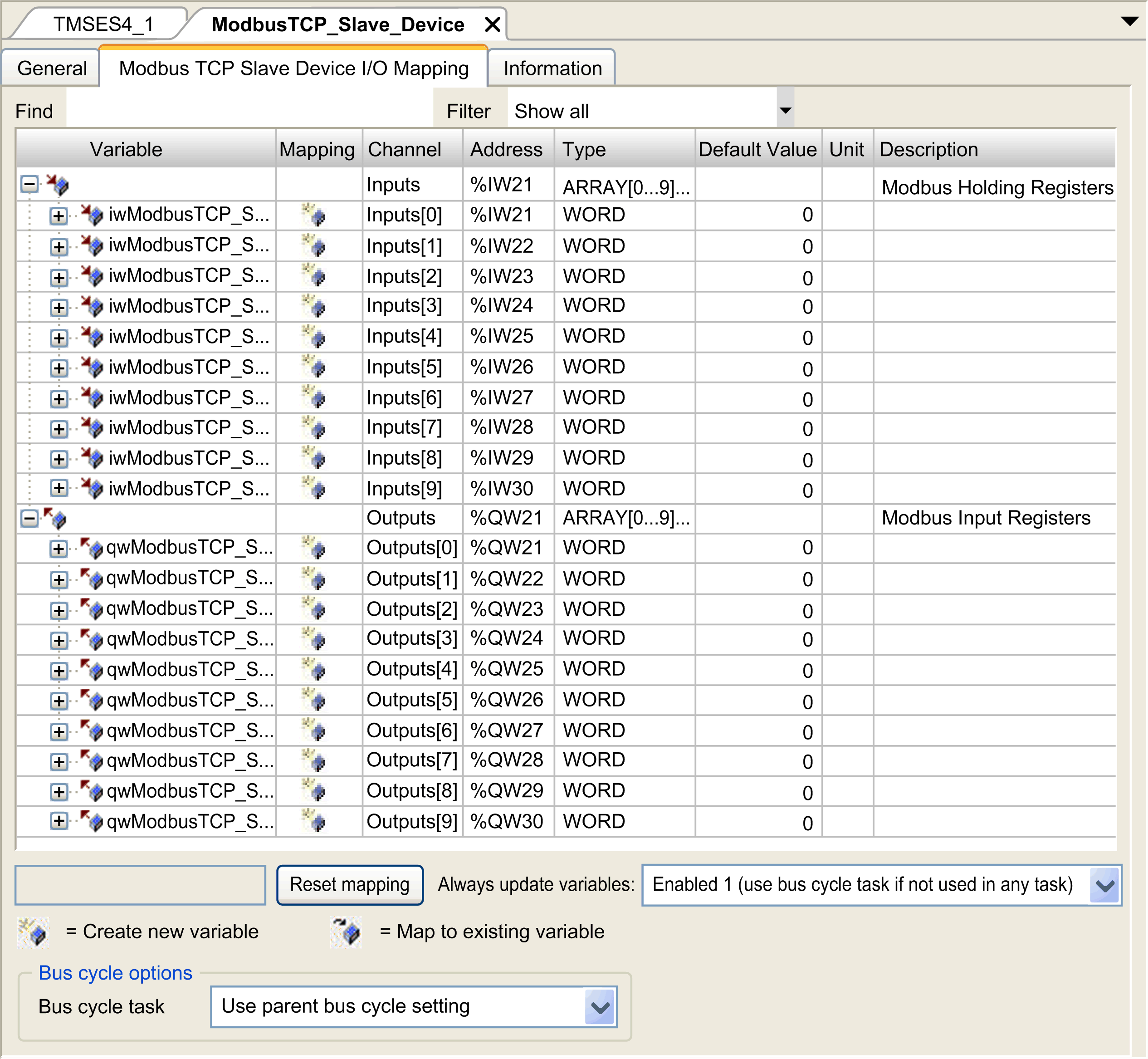Modicon M262 Logic/Motion Controller as a Slave Device on Modbus TCP
Overview
This section describes the configuration of the M262 Logic/Motion Controller as a .
To configure your M262 Logic/Motion Controller as a , you must add functionality to your controller (see Adding a Modbus TCP Slave Device).
This functionality creates a specific I/O area in the controller that is accessible with the Modbus TCP protocol. This I/O area is used whenever an external master needs to access the %IW and %QW objects of the controller. This functionality allows you to provide the controller I/O objects to this area, which can then be accessed with a single Modbus read/write registers request.
The adds another Modbus server function to the controller. This server is addressed by the Modbus client application by specifying a configured Unit ID (Modbus address) in the range 1...247. The embedded Modbus server of the slave controller needs no configuration, and is addressed by specifying a Unit ID equal to 255. See the Modbus TCP Configuration.
Inputs/outputs are seen from the slave controller: inputs are written by the master, and outputs are read by the master.
The can define a privileged Modbus client application, whose connection is not forcefully closed (embedded Modbus connections may be closed when more than eight connections are needed).
The timeout duration associated to the privileged connection allows you to verify whether the controller is being polled by the privileged master. If no Modbus request is received within the timeout duration, the diagnostic information i_byMasterIpLost is set to 1 (TRUE). For more information, see the Ethernet Port Read Only System Variables.
For further information about Modbus TCP, see the www.modbus.org website.
Adding a Modbus TCP Slave Device
To add Modbus TCP slave device functionality to your M262 Logic/Motion Controller:
|
Step |
Action |
|---|---|
|
1 |
Add a TMSES4 expansion module to your configuration. |
|
2 |
From the node in the , add the by selecting it in the , dragging it to the , and dropping it on the node. For more information on adding a device to your project, refer to: • Using the Drag-and-drop Method • Using the Contextual Menu or Plus Button |
Configuring a Modbus TCP Slave Device
To configure the Modbus TCP slave device, double-click in the .
This dialog box appears:

|
Element |
Description |
|---|---|
|
|
IP address of the Modbus master The connections are not closed on this address. |
|
|
Timeout in 500 ms increments
NOTE: The timeout applies to the unless the address is 0.0.0.0.
|
|
|
Modbus communication port (502) |
|
|
Sends the requests to the Modbus TCP slave device (1...247), instead of the embedded Modbus server (255). |
|
|
Number of %IW registers to be used in the exchange (2...120) (each register is 2 bytes) |
|
|
Number of %QW registers to be used in the exchange (2...120) (each register is 2 bytes) |
Tab
The I/Os are mapped to Modbus registers from the master perspective in the following way:
-
%IWs are mapped from register 0 to n-1 and are R/W (n = Holding register quantity, each %IW register is 2 bytes).
-
%QWs are mapped from register n to n+m -1 and are read only (m = Input registers quantity, each %QW register is 2 bytes).
When a has been configured, Modbus commands sent to its Unit ID (Modbus address) are handled differently than the same command would be when addressed to any other Modbus device on the network. For example, when the Modbus command 3 (3 hex) is sent to a Modbus device, it reads and returns the value of one or more registers. When this same command is sent to the Modbus TCP Slave, it facilitates a read operation by the external I/O scanner.
When a has been configured, Modbus commands sent to its Unit ID (Modbus address) access to the %IW and %QW objects of the controller, linked to the Modbus TCP device, instead of the regular Modbus words (accessed when the Unit ID is 255). This facilitates read/write operations by a Modbus TCP IOScanner application.
The responds to a subset of the Modbus commands with the purpose of exchanging data with the external I/O scanner. The following Modbus commands are supported by the :
|
Function Code Dec (Hex) |
Function |
Comment |
|---|---|---|
|
3 (3) |
Read holding register |
Allows the master to read %IW and %QW objects of the device |
|
6 (6) |
Write single register |
Allows the master to write %IW objects of the device |
|
16 (10) |
Write multiple registers |
Allows the master to write %IW objects of the device |
|
23 (17) |
Read/write multiple registers |
Allows the master to read %IW and %QW objects of the device and write %IW objects of the device |
|
Other |
Not supported |
– |
To link I/O objects to variables, select the tab:

|
Channel |
Type |
Description |
|
|---|---|---|---|
|
|
IW0 |
WORD |
Holding register 0 |
|
... |
... |
... |
|
|
IWx |
WORD |
Holding register x |
|
|
|
QW0 |
WORD |
Input register 0 |
|
... |
... |
... |
|
|
QWy |
WORD |
Input register y |
|
The number of words depends on the Holding Registers (%IW) and Input Registers (%QW) parameters of the tab.